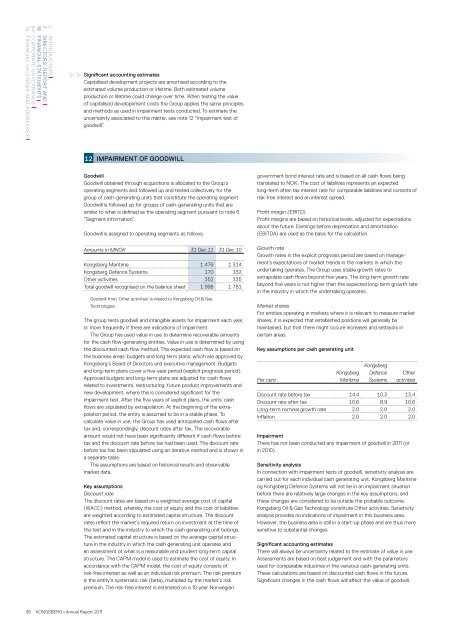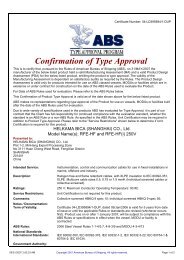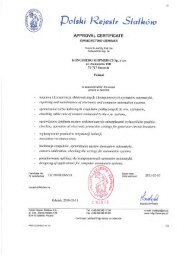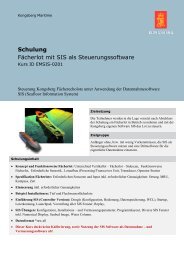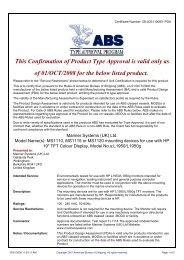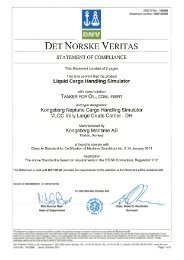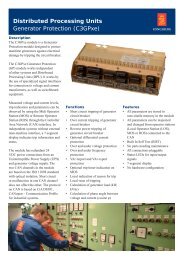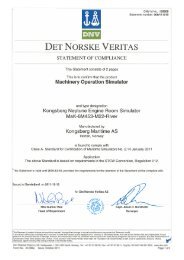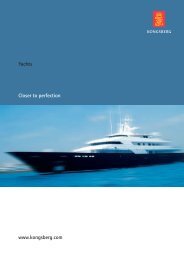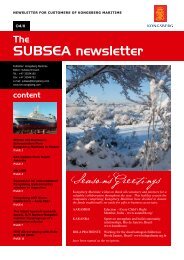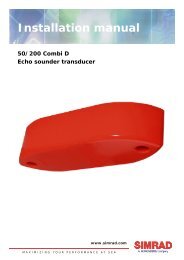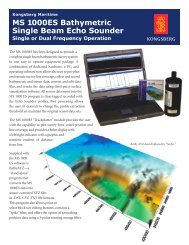Annual Report 2011 - Kongsberg Maritime - Kongsberg Gruppen
Annual Report 2011 - Kongsberg Maritime - Kongsberg Gruppen
Annual Report 2011 - Kongsberg Maritime - Kongsberg Gruppen
You also want an ePaper? Increase the reach of your titles
YUMPU automatically turns print PDFs into web optimized ePapers that Google loves.
2 INTRODUCTION<br />
7 DIRECTORS’ REPORT AND<br />
18 FINANCIAL STATEMENTS<br />
64 CORPORATE GOVERNANCE<br />
76 FINANCIAL CALENDAR AND ADDRESSES<br />
12<br />
36 KONGSBERG <strong>Annual</strong> <strong>Report</strong> <strong>2011</strong><br />
Significant accounting estimates<br />
Capitalised development projects are amortised according to the<br />
esti mated volume production or lifetime. Both estimated volume<br />
pro duction or lifetime could change over time. When testing the value<br />
of capitalised developement costs the Group applies the same principles<br />
and methods as used in impairment tests conducted. To estimate the<br />
uncertainity associated to this matter, see note 12 “Impairment test of<br />
goodwill”.<br />
IMPAIRMENT OF GOODWILL<br />
Goodwill<br />
Goodwill obtained through acquisitions is allocated to the Group’s<br />
operating segments and followed up and tested collectively for the<br />
group of cash-generating units that constitute the operating segment.<br />
Goodwill is followed up for groups of cash-generating units that are<br />
similar to what is defined as the operating segment pursuant to note 6<br />
“Segment information”.<br />
Goodwill is assigned to operating segments as follows:<br />
Amounts in MNOK 31 Dec 11 31 Dec 10<br />
<strong>Kongsberg</strong> <strong>Maritime</strong> 1 476 1 314<br />
<strong>Kongsberg</strong> Defence Systems 170 132<br />
Other activities 352 335<br />
Total goodwill recognised on the balance sheet 1 998 1 781<br />
Goodwill from ‘Other activities’ is related to <strong>Kongsberg</strong> Oil & Gas<br />
Technologies.<br />
The group tests goodwill and intangible assets for impairment each year,<br />
or more frequently if there are indications of impairment.<br />
The Group has used value in use to determine recoverable amounts<br />
for the cash flow-generating entities. Value in use is determined by using<br />
the discounted cash flow method. The expected cash flow is based on<br />
the business areas’ budgets and long term plans, which are approved by<br />
<strong>Kongsberg</strong>’s Board of Directors and executive management. Budgets<br />
and long-term plans cover a five-year period (explicit prognosis period).<br />
Approved budgets and long-term plans are adjusted for cash flows<br />
related to investments, restructuring, future product improvements and<br />
new development, where this is considered significant for the<br />
impairment test. After the five years of explicit plans, the units’ cash<br />
flows are stipulated by extrapolation. At the beginning of the extrapolation<br />
period, the entity is assumed to be in a stable phase. To<br />
calculate value in use, the Group has used anticipated cash flows after<br />
tax and, correspondingly, discount rates after tax. The recoverable<br />
amount would not have been significantly different if cash flows before<br />
tax and the discount rate before tax had been used. The discount rate<br />
before tax has been stipulated using an iterative method and is shown in<br />
a separate table.<br />
The assumptions are based on historical results and observable<br />
market data.<br />
Key assumptions<br />
Discount rate<br />
The discount rates are based on a weighted average cost of capital<br />
(WACC) method, whereby the cost of equity and the cost of liabilities<br />
are weighted according to estimated capital structure. The discount<br />
rates reflect the market’s required return on investment at the time of<br />
the test and in the industry to which the cash generating unit belongs.<br />
The estimated capital structure is based on the average capital structure<br />
in the industry in which the cash generating unit operates and<br />
an assessment of what is a reasonable and prudent long-term capital<br />
structure. The CAPM model is used to estimate the cost of equity. In<br />
accordance with the CAPM model, the cost of equity consists of<br />
risk-free interest as well as an individual risk premium. The risk premium<br />
is the entity’s systematic risk (beta), multiplied by the market’s risk<br />
premium. The risk-free interest is estimated on a 10-year Norwegian<br />
government bond interest rate and is based on all cash flows being<br />
translated to NOK. The cost of liabilities represents an expected<br />
long-term after-tax interest rate for comparable liabilities and consists of<br />
risk-free interest and an interest spread.<br />
Profit margin (EBITD)<br />
Profit margins are based on historical levels, adjusted for expectations<br />
about the future. Earnings before depreciation and amortisation<br />
(EBITDA) are used as the basis for the calculation.<br />
Growth rate<br />
Growth rates in the explicit prognosis period are based on management’s<br />
expectations of market trends in the markets in which the<br />
undertaking operates. The Group uses stable growth rates to<br />
extrapolate cash flows beyond five years. The long-term growth rate<br />
beyond five years is not higher than the expected long-term growth rate<br />
in the industry in which the undertaking operates.<br />
Market shares<br />
For entities operating in markets where it is relevant to measure market<br />
shares, it is expected that established positions will generally be<br />
maintained, but that there might occure increases and setbacks in<br />
certain areas.<br />
Key assumptions per cash generating unit<br />
Per cent<br />
<strong>Kongsberg</strong><br />
<strong>Maritime</strong><br />
<strong>Kongsberg</strong><br />
Defence<br />
Systems<br />
Other<br />
activities<br />
Discount rate before tax 14.4 10.3 13.4<br />
Discount rate after tax 10.6 8.9 10.6<br />
Long-term nominal growth rate 2.0 2.0 2.0<br />
Inflation 2.0 2.0 2.0<br />
Impairment<br />
There has not been conducted any impairment of goodwill in <strong>2011</strong> (or<br />
in 2010).<br />
Sensitivity analysis<br />
In connection with impairment tests of goodwill, sensitivity analysis are<br />
carried out for each individual cash generating unit. <strong>Kongsberg</strong> <strong>Maritime</strong><br />
og <strong>Kongsberg</strong> Defence Systems will not be in an impairment situation<br />
before there are relatively large changes in the key assumptions, and<br />
these changes are considered to be outside the probable outcome.<br />
<strong>Kongsberg</strong> Oil & Gas Technology constitute Other activities. Sensitivity<br />
analysis provides no indications of impairment in this business area.<br />
However, the business area is still in a start-up phase and are thus more<br />
sensitive to substantial changes.<br />
Significant accounting estimates<br />
There will always be uncertainty related to the estimate of value in use.<br />
Assessments are based on best judgement and with the parameters<br />
used for comparable industries in the varuious cash-generating units.<br />
These calculations are based on discounted cash flows in the future.<br />
Significant changes in the cash flows will affect the value of goodwill.


